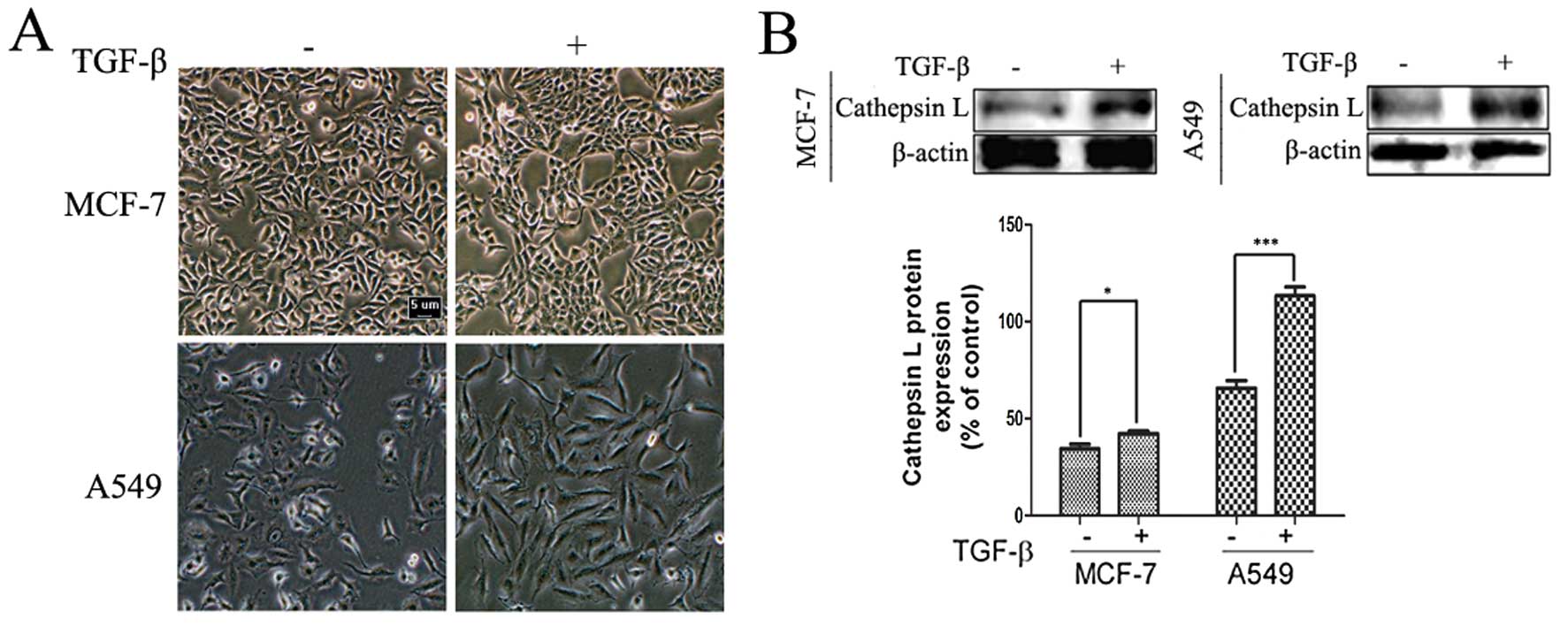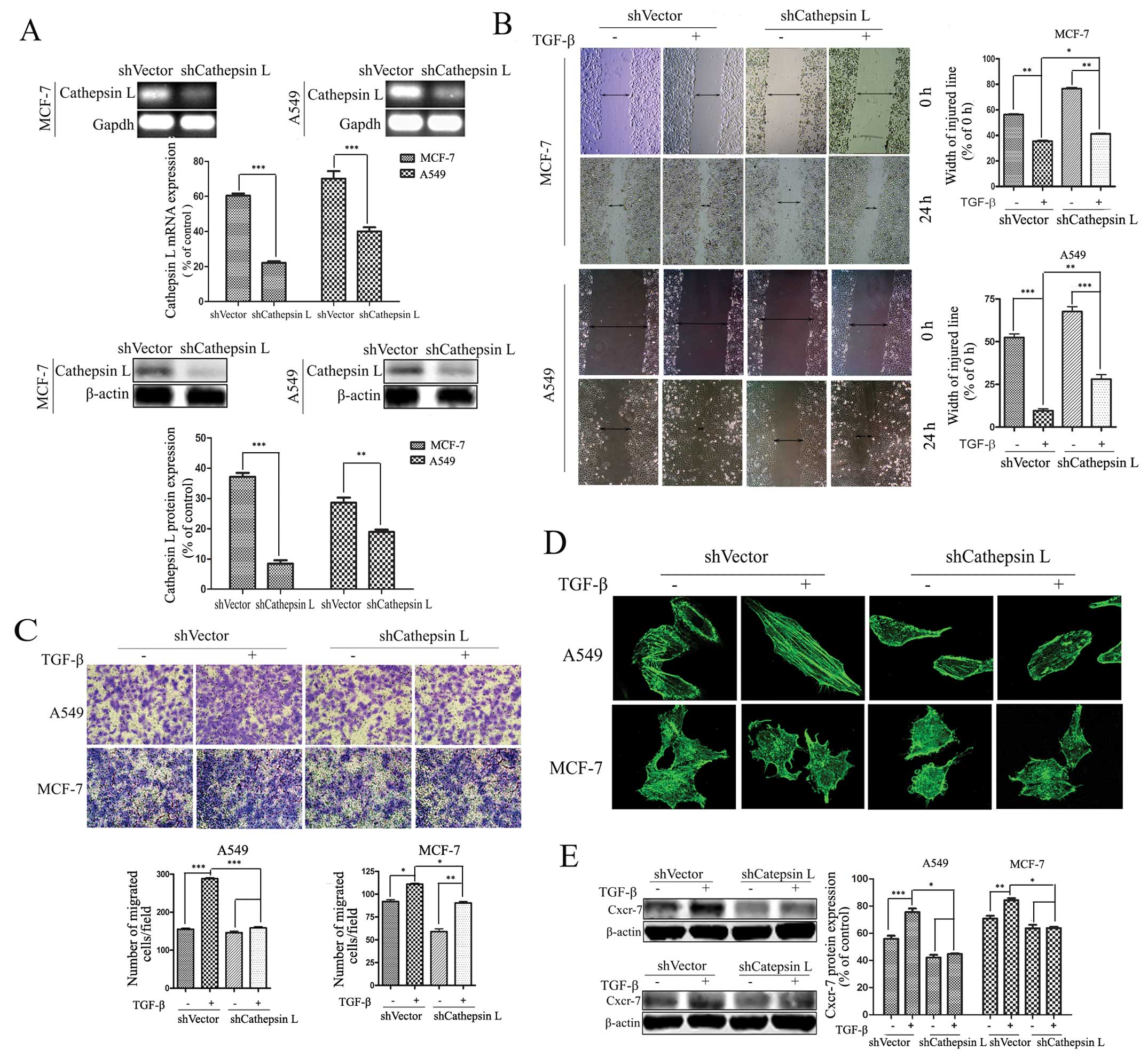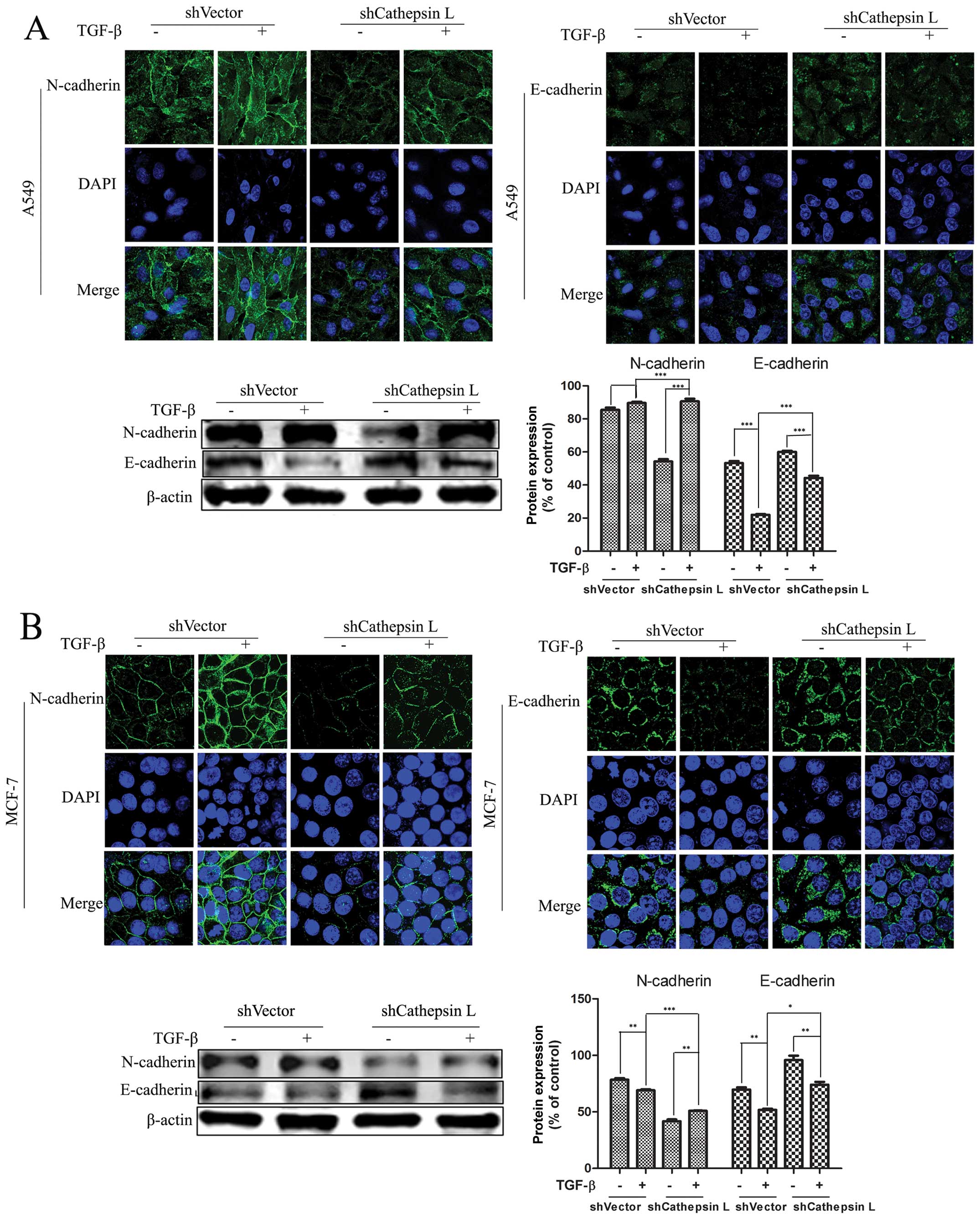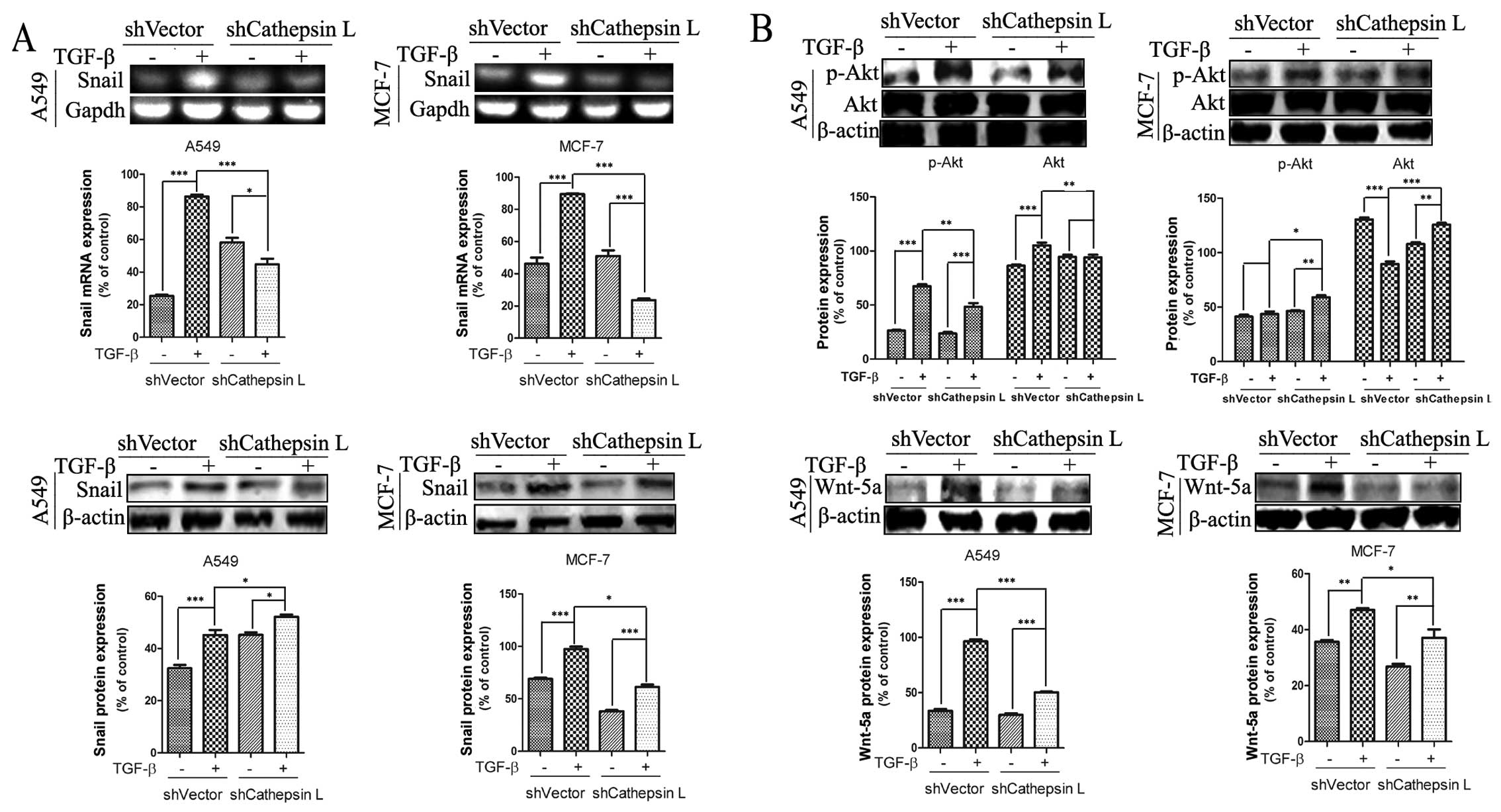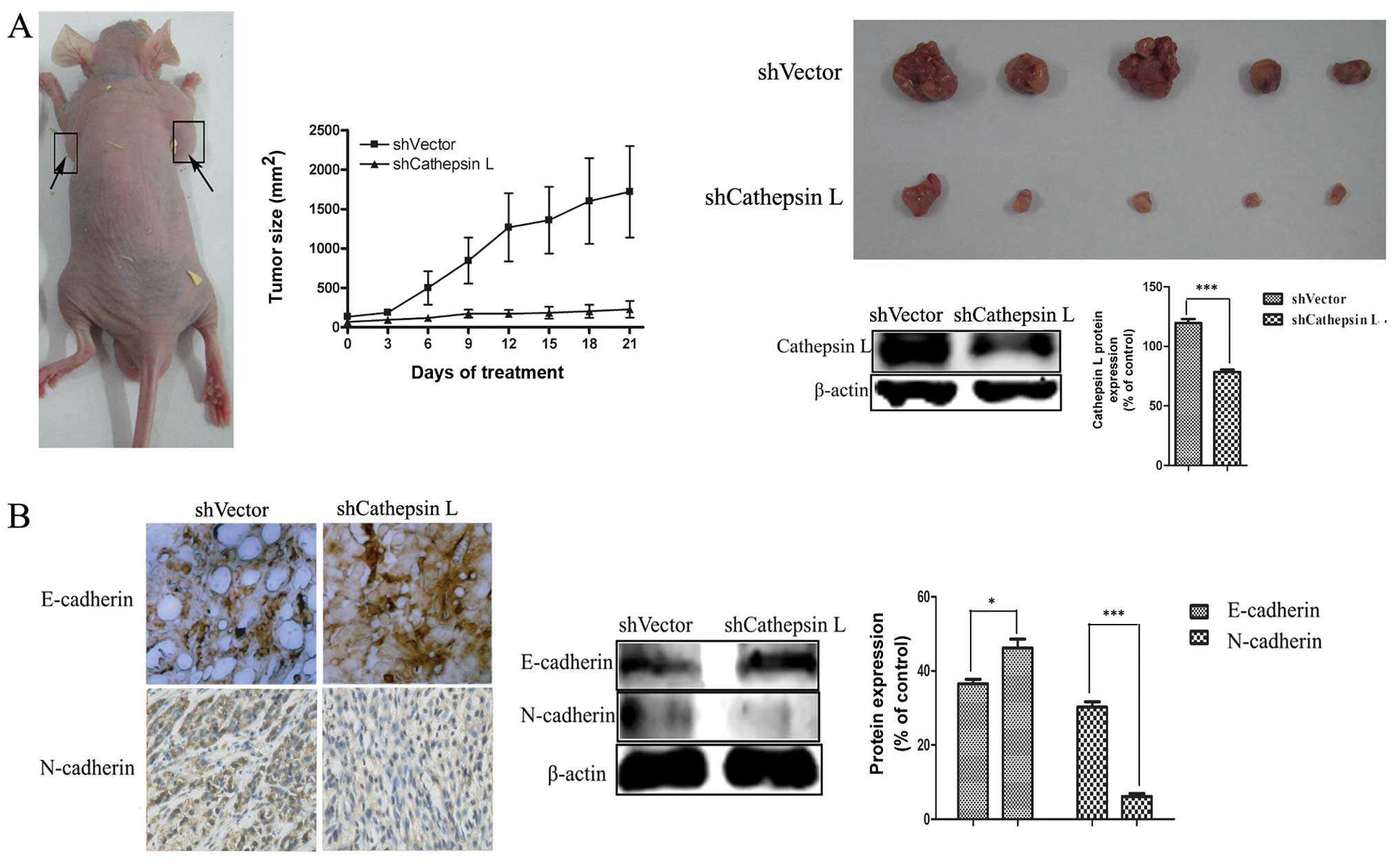|
1
|
Thiery JP and Sleeman JP: Complex networks
orchestrate epithelial-mesenchymal transitions. Nat Rev Mol Cell
Biol. 7:131–142. 2006. View
Article : Google Scholar : PubMed/NCBI
|
|
2
|
Fan F, Samuel S, Evans KW, Lu J, Xia L,
Zhou Y, Sceusi E, Tozzi F, Ye XC, Mani SA and Ellis LM:
Overexpression of snail induces epithelial-mesenchymal transition
and a cancer stem cell-like phenotype in human colorectal cancer
cells. Cancer Med. 1:5–16. 2012. View
Article : Google Scholar
|
|
3
|
Shi J, Wang DM, Wang CM, Hu Y, Liu AH,
Zhang YL, Sun B and Song JG: Insulin receptor substrate-1
suppresses transforming growth factor-β1-mediated
epithelial-mesenchymal transition. Cancer Res. 69:7180–7187. 2009.
View Article : Google Scholar : PubMed/NCBI
|
|
4
|
Voulgari A and Pintzas A:
Epithelial-mesenchymal transition in cancer metastasis: mechanisms,
markers and strategies to overcome drug resistance in the clinic.
Biochim Biophys Acta. 1796:75–90. 2009.PubMed/NCBI
|
|
5
|
Hugo H, Ackland ML, Blick T, Lawrence MG,
Clements JA, Williams ED and Thompson EW: Epithelial - mesenchymal
and mesenchymal - epithelial transitions in carcinoma progression.
J Cell Physiol. 213:374–383. 2007. View Article : Google Scholar : PubMed/NCBI
|
|
6
|
Saito RA, Watabe T, Horiguchi K, Kohyama
T, Saitoh M, Nagase T and Miyazono K: Thyroid transcription
factor-1 inhibits transforming growth factor-β-mediated
epithelial-to-mesenchymal transition in lung adenocarcinoma cells.
Cancer Res. 69:2783–2791. 2009. View Article : Google Scholar : PubMed/NCBI
|
|
7
|
Lim S, Becker A, Zimmer A, Lu J, Buettner
R and Kirfel J: SNAI1-mediated epithelial-mesenchymal transition
confers chemoresistance and cellular plasticity by regulating genes
involved in cell death and stem cell maintenance. PLoS One.
8:e665582013. View Article : Google Scholar : PubMed/NCBI
|
|
8
|
Pardali K and Moustakas A: Actions of
TGF-beta as tumor suppressor and pro-metastatic factor in human
cancer. Biochim Biophys Acta. 1775:21–62. 2007.
|
|
9
|
Gupta M, Korol A and West-Mays JA: Nuclear
translocation of myocardin-related transcription factor-A during
transforming growth factor beta-induced epithelial to mesenchymal
transition of lens epithelial cells. Mol Vis. 19:1017–1028.
2013.PubMed/NCBI
|
|
10
|
Naber HP, Drabsch Y, Snaar-Jagalska BE, et
al: Snail and Slug, key regulators of TGF-β-induced EMT, are
sufficient for the induction of single-cell invasion. Biochem
Biophys Res Commun. 435:58–63. 2013. View Article : Google Scholar : PubMed/NCBI
|
|
11
|
Levicar N, Nuttall RK and Lah TT:
Proteases in brain tumor progression. Acta Neurochir. 145(Wien):
825–838. 2003. View Article : Google Scholar
|
|
12
|
Yong VW: Metalloproteinases: mediators of
pathology and regeneration in the CNS. Nat Rev Neurosci. 6:931–944.
2005. View
Article : Google Scholar : PubMed/NCBI
|
|
13
|
Harada T, Arii S, Mise M, et al:
Membrane-type matrix metalloproteinase-1(MT 1-MMP) gene is
overexpressed in highly invasive hepatocellular carcinomas. J
Hepatol. 28:231–239. 1998. View Article : Google Scholar : PubMed/NCBI
|
|
14
|
Wang JR, Li XH, Gao XJ, et al: Expression
of MMP-13 is associated with invasion and metastasis of papillary
thyroid carcinoma. Eur Rev Med Pharmacol Sci. 17:427–435.
2013.PubMed/NCBI
|
|
15
|
Brix K, Dunkhorst A, Mayer K and Jordan S:
Cysteine cathepsins: cellular roadmap to different functions.
Biochimie. 90:194–207. 2008. View Article : Google Scholar
|
|
16
|
Bylaite M, Moussali H, Marciukaitiene I,
et al: Expression of cathepsin L and its inhibitor hurpin in
inflammatory and neoplastic skin diseases. Exp Dermatol.
15:110–118. 2006. View Article : Google Scholar : PubMed/NCBI
|
|
17
|
Stahl S, Reinders Y, Asan E, et al:
Proteomic analysis of cathepsin B- and L-deficient mouse brain
lysosomes. Biochimica Biophysica Acta. 1774:1237–1246. 2007.
View Article : Google Scholar
|
|
18
|
Skrzydlewska E, Sulkowska M, Koda M and
Sulkowski S: Proteolytic-antiproteolytic balance and its regulation
in carcinogenesis. World J Gastroenterol. 11:1251–1266. 2005.
View Article : Google Scholar : PubMed/NCBI
|
|
19
|
Navab R, Pedraza C, Fallavollita L, et al:
Loss of responsiveness to IGF-I in cells with reduced cathepsin L
expression levels. Oncogene. 27:4973–4985. 2008. View Article : Google Scholar : PubMed/NCBI
|
|
20
|
Pucer A, Castino R, Mirković B, et al:
Differential role of cathepsins B and L in autophagy-associated
cell death induced by arsenic trioxide in U87 human glioblastoma
cells. Biol Chem. 391:519–531. 2010. View Article : Google Scholar : PubMed/NCBI
|
|
21
|
Zajc I, Hreljac I and Lah T: Cathepsin L
affects apoptosis of glioblastoma cells: a potential implication in
the design of cancer therapeutics. Anticancer Res. 26:3357–3364.
2006.PubMed/NCBI
|
|
22
|
Strojnik T, Kos J, Zidanik B, et al:
Cathepsin B immunohistochemical staining in tumor and endothelial
cells is a new prognostic factor for survival in patients with
brain tumors. Clin Cancer Res. 5:559–567. 1999.PubMed/NCBI
|
|
23
|
Kirschke H, Eerola R, Hopsu-Havu VK, et
al: Antisense RNA inhibition of cathepsin L expression reduces
tumorigenicity of malignant cells. Eur J Cancer. 36:787–795. 2000.
View Article : Google Scholar : PubMed/NCBI
|
|
24
|
Gocheva V and Joyce JA: Cysteine
cathepsins and the cutting edge of cancer invasion. Cell Cycle.
6:60–64. 2007. View Article : Google Scholar : PubMed/NCBI
|
|
25
|
Jedeszko C and Sloane BF: Cysteine
cathepsins in human cancer. Biol Chem. 385:1017–1027. 2004.
View Article : Google Scholar : PubMed/NCBI
|
|
26
|
Mohamed MM and Sloane BF: Cysteine
cathepsins: multifunctional enzymes in cancer. Nat Rev Cancer.
6:764–775. 2006. View
Article : Google Scholar : PubMed/NCBI
|
|
27
|
Strojnik T, Kavalar R, Trinkaus M and Lah
TT: Cathepsin L in glioma progression: comparison with cathepsin B.
Cancer Detect Prev. 29:448–455. 2005. View Article : Google Scholar : PubMed/NCBI
|
|
28
|
Chambers AF, Colella R, Denhardt DT and
Wilson SM: Increased expression of cathepsins L and B and decreased
activity of their inhibitors in metastatic, ras-transformed NIH 3T3
cells. Mol Carcinog. 5:238–245. 1992. View Article : Google Scholar : PubMed/NCBI
|
|
29
|
Frade R, Rodrigues-Lima F, Huang S, et al:
Procathepsin-L, a proteinase that cleaves human C3 (the third
component of complement), confers high tumorigenic and metastatic
properties to human melanoma cells. Cancer Res. 58:2733–2736.
1998.PubMed/NCBI
|
|
30
|
Yang Z and Cox JL: Cathepsin L increases
invasion and migration of B16 melanoma. Cancer Cell Int. 7:82007.
View Article : Google Scholar : PubMed/NCBI
|
|
31
|
Rousselet N, Mills L, Jean D, et al:
Inhibition of tumorigenicity and metastasis of human melanoma cells
by anti-cathepsin L single chain variable fragment. Cancer Res.
64:146–151. 2004. View Article : Google Scholar : PubMed/NCBI
|
|
32
|
Wang SM, Li L, Zhang W, et al:
Relationship between cathepsin L and invasion and metastasis of
ovarian carcinoma cells. Zhonghua Fu Chan Ke Za Zhi. 45:598–602.
2010.(In Chinese). PubMed/NCBI
|
|
33
|
Lah TT, Durán Alonso MB and Van Noorden
CJ: Antiprotease therapy in cancer: hot or not? Expert Opin Biol
Ther. 6:257–279. 2006. View Article : Google Scholar : PubMed/NCBI
|
|
34
|
Goulet B, Sansregret L, Leduy L, et al:
Increased expression and activity of nuclear cathepsin L in cancer
cells suggests a novel mechanism of cell transformation. Mol Cancer
Res. 5:899–907. 2007. View Article : Google Scholar : PubMed/NCBI
|
|
35
|
Krueger S, Kellner U, Buehling F, et al:
Cathepsin L antisense oligonucleotides in a human osteosarcoma cell
line: effects on the invasive phenotype. Cancer Gene Ther.
8:522–528. 2001. View Article : Google Scholar : PubMed/NCBI
|
|
36
|
Matarrese P, Ascione B, Ciarlo L, et al:
Cathepsin B inhibition interferes with metastatic potential of
human melanoma: an in vitro and in vivo study. Mol Cancer.
9:2072010. View Article : Google Scholar : PubMed/NCBI
|
|
37
|
Shintani Y, Okimura A, Sato K, et al:
Epithelial to mesenchymal transition is a determinant of
sensitivity to chemoradiotherapy in non-small cell lung cancer. Ann
Thorac Surg. 92:1794–1804. 2011. View Article : Google Scholar : PubMed/NCBI
|
|
38
|
Hao M, Zheng J, Hou K, et al: Role of
chemokine receptor CXCR7 in bladder cancer progression. Biochem
Pharmacol. 84:204–214. 2012. View Article : Google Scholar : PubMed/NCBI
|
|
39
|
Bi WR, Jin CX, Xu GT and Yang CQ: Bone
morphogenetic protein-7 regulates Snail signaling in carbon
tetrachloride-induced fibrosis in the rat liver. Exp Ther Med.
4:1022–1026. 2012.PubMed/NCBI
|
|
40
|
Nieto MA: The Snail superfamily of
zinc-finger transcription factors. Nat Rev Mol Cell Biol.
3:155–166. 2002. View
Article : Google Scholar : PubMed/NCBI
|
|
41
|
Shin SY, Rath O, Zebisch A, et al:
Functional roles of multiple feedback loops in extracellular
signal-regulated kinase and Wnt signaling pathways that regulate
epithelial-mesenchymal transition. Cancer Res. 70:6715–6724. 2010.
View Article : Google Scholar : PubMed/NCBI
|
|
42
|
Eger A, Stockinger A, Park J, et al:
beta-Catenin and TGFbeta signalling cooperate to maintain a
mesenchymal phenotype after FosER-induced epithelial to mesenchymal
transition. Oncogene. 23:2672–2680. 2004. View Article : Google Scholar : PubMed/NCBI
|
|
43
|
Xiao D and He J: Epithelial mesenchymal
transition and lung cancer. J Thorac Dis. 2:154–159.
2010.PubMed/NCBI
|
|
44
|
Chunhacha P, Sriuranpong V and
Chanvorachote P: Epithelial-mesenchymal transition mediates anoikis
resistance and enhances invasion in pleural effusion-derived human
lung cancer cells. Oncol Lett. 5:1043–1047. 2013.PubMed/NCBI
|
|
45
|
Davies M, Robinson M, Smith E, et al:
Induction of an epithelial to mesenchymal transition in human
immortal and malignant keratinocytes by TGF-beta1 involves MAPK,
Smad and AP-1 signalling pathways. J Cell Biochem. 95:918–931.
2005. View Article : Google Scholar : PubMed/NCBI
|
|
46
|
Amuthan G, Biswas G, Ananadatheerthavarada
HK, et al: Mitochondrial stress-induced calcium signaling,
phenotypic changes and invasive behavior in human lung carcinoma
A549 cells. Oncogene. 21:7839–7849. 2002. View Article : Google Scholar : PubMed/NCBI
|
|
47
|
Krueger S, Kellner U, Buehling F and
Roessner A: Cathepsin L antisense oligonucleotides in a humall
osteosarcoma cell line: efects on the invasive phenotype. Cancer
Gene Ther. 8:522–528. 2001. View Article : Google Scholar : PubMed/NCBI
|
|
48
|
Gocheva V, Zeng W, Ke D, et al: Distinct
roles for cysteine cathepsin genes in multistage tumorigenesis.
Genes Dev. 20:543–556. 2006. View Article : Google Scholar : PubMed/NCBI
|
|
49
|
Thiery JP, Acloque H, Huang RY and Nieto
MA: Epithelial-mesenchymal transitions in development and disease.
Cell. 139:871–890. 2009. View Article : Google Scholar : PubMed/NCBI
|
|
50
|
Zhang Q, Bai X, Chen W, et al:
Wnt/β-catenin signaling enhances hypoxia-induced
epithelial-mesenchymal transition in hepatocellular carcinoma via
crosstalk with hif-1α signaling. Carcinogenesis. 34:962–973. 2013.
View Article : Google Scholar : PubMed/NCBI
|
|
51
|
Peinado H, Olmeda D and Cano A: Snail, Zeb
and bHLH factors in tumour progression: an alliance against the
epithelial phenotype? Nat Rev Cancer. 7:415–428. 2007. View Article : Google Scholar : PubMed/NCBI
|
|
52
|
Hanahan D: Heritable formation of
pancreatic beta-cell tumours in transgenic mice expressing
recombinant insulin/simian virus 40 oncogenes. Nature. 315:115–122.
1985. View Article : Google Scholar : PubMed/NCBI
|
|
53
|
Lee SY, Jeon HM, Ju MK, et al: Wnt/Snail
signaling regulates cytochrome c oxidase and glucose metabolism.
Cancer Res. 72:3607–3617. 2012. View Article : Google Scholar : PubMed/NCBI
|
|
54
|
Kumawat K, Menzen MH, Slegtenhorst RM,
Halayko AJ, Schmidt M and Gosens R: TGF-β-activated kinase 1 (TAK1)
signaling regulates TGF-β-induced WNT-5A expression in airway
smooth muscle cells via Sp1 and β-catenin. PLoS One. 9:e948012014.
View Article : Google Scholar
|



